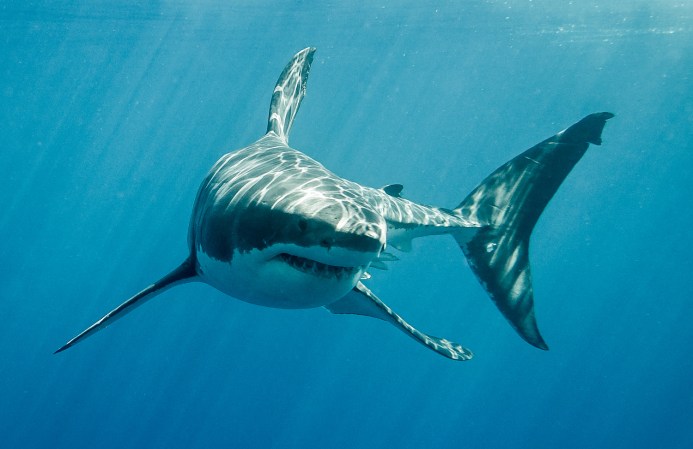

This article was originally featured on Hakai Magazine, an online publication about science and society in coastal ecosystems. Read more stories like this at hakaimagazine.com.
They found the victims floating in the water. Some had eyeballs full of air bubbles, others had their stomachs pushed up into their mouths. Many had severe internal bleeding.
Volcanoes can be life-threatening for fish. A major eruption in 2011 in Chile, for instance, killed 4.5 million of them. Researchers have studied how lava flows, hot gases, and deadly debris can cause mass die-offs or even cut fish off from the sea in suddenly landlocked lakes. But few have been able to document in detail the grisly fates experienced by the unlucky fish that find themselves at the mercy of an angry volcano. That’s why when one erupted underwater off the coast of El Hierro in the Canary Islands for 150 days in late 2011 and early 2012, researchers including Ayoze Castro Alonso at the University of Las Palmas de Gran Canaria saw the perfect opportunity to study the intricacies of these piscine casualties.
Ten years later, the devastating eruption of a terrestrial volcano on nearby La Palma, another of the Canary Islands, gave Alonso and his colleagues a chance to see an altogether different way that volcanoes can butcher unsuspecting fish—by overwhelming them with debris.
The scientists detail in a new paper the shocking injuries suffered by 49 fishes killed by the El Hierro eruption and 14 fishes killed by the volcanism near La Palma. “It’s a volcanic eruption in both cases, but the pathological syndromes are completely different,” says Alonso. “One is acute, the other is chronic.”
The underwater eruption near El Hierro superheated the water by as much as 19 °C, reduced the oxygen level, and rapidly acidified the ocean. Alonso and his colleagues found fishes with gas bubbles in their bodies. The team concluded the injuries occurred while the fishes were still alive because the scientists found inflammatory cells indicative of physical trauma and a severe build-up of blood in the fishes’ tissues.
The researchers’ detailed necropsies also hint that the fishes made a fateful dash for safety. Once the El Hierro eruption was underway, Alonso says, the fishes ascended rapidly. “They tried to escape,” he says.
As the fishes swam upward, sudden depressurization likely caused the gases dissolved in their bodies to bubble out, accounting for the bubbles in their eyes and under their skin. Depressurization would also explain why the animals’ stomachs were pushed up into their mouths and why some had overinflated swim bladders. These gas-filled organs expand when fish rise toward the surface.
On La Palma, though, molten lava flowed over land and into the ocean where the sudden clash with cold water quenched it into a glassy rock known as hyaloclastite. Within a week, huge clouds of volcanic ash settled into the water. Fish died after their gills became clogged with ash, or after their digestive tracts were impacted with fragments of glassy hyaloclastite.
Some of the findings are familiar to Todd Crowl, an ecosystem scientist at Florida International University who was not involved in the current study but who witnessed an eruption on Dominica in the Caribbean during the 1990s. A few centimeters of ash fell on the island, Crowl says, contaminating streams and killing thousands of filter-feeding shrimp. “All that ash just completely clogged up [the shrimp’s] filters,” he says.
Alonso and his colleagues’ research is the first to analyze the wounds fish suffer during a volcanic eruption in such detail—in part because getting access to the victims while their bodies are still fresh is incredibly difficult. After the eruptions at El Hierro and La Palma, local officials gathered up stricken fishes and shipped them on ice to the researchers within a matter of days.
Crowl says this rapid collection let the scientists conduct their analyses before the fishes rotted away. “We get fish kills all the time in Florida because of algal blooms and stuff like that,” Crowl says. “But by the time we get the specimens, there’s lots of degradation.”
Volcano ecologist Charlie Crisafulli, formerly of the US Forest Service, who was not involved in the work, agrees that the study of such fresh victims is novel: “We haven’t seen this before.” However, Crisafulli isn’t certain that the fishes killed by the El Hierro eruption actively tried to flee. Alternatively, they might have been stunned by the rapid changes in their environment and simply floated upward in a state of shock.
Though all of this seems deeply unpleasant, Crisafulli stresses there is a bigger picture here worth thinking about. Volcanoes kill, but they also create. Eruptions contribute nutrients to the environment, and lava flows build new land—sometimes entire islands.
“With this so-called destruction and loss of life, also there’s the creation of new habitats,” Crisafulli says. “What was initially a loss ends up becoming a gain through time.”
This article first appeared in Hakai Magazine and is republished here with permission.























